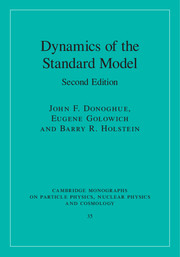Book contents
- Frontmatter
- Dedication
- Contents
- Preface to the second edition
- I Inputs to the Standard Model
- II Interactions of the Standard Model
- III Symmetries and anomalies
- IV Introduction to effective field theory
- V Charged leptons
- VI Neutrinos
- VII Effective field theory for low-energy QCD
- VIII Weak interactions of kaons
- IX Mass mixing and CP violation
- X The N−1c expansion
- XI Phenomenological models
- XII Baryon properties
- XIII Hadron spectroscopy
- XIV Weak interactions of heavy quarks
- XV The Higgs boson
- XVI The electroweak sector
- Appendix A Functional integration
- Appendix B Advanced field-theoretic methods
- Appendix C Useful formulae
- References
- Index
Preface to the second edition
- Frontmatter
- Dedication
- Contents
- Preface to the second edition
- I Inputs to the Standard Model
- II Interactions of the Standard Model
- III Symmetries and anomalies
- IV Introduction to effective field theory
- V Charged leptons
- VI Neutrinos
- VII Effective field theory for low-energy QCD
- VIII Weak interactions of kaons
- IX Mass mixing and CP violation
- X The N−1c expansion
- XI Phenomenological models
- XII Baryon properties
- XIII Hadron spectroscopy
- XIV Weak interactions of heavy quarks
- XV The Higgs boson
- XVI The electroweak sector
- Appendix A Functional integration
- Appendix B Advanced field-theoretic methods
- Appendix C Useful formulae
- References
- Index
Summary
The Standard Model is the basis of our understanding of the fundamental interactions. At the present time, it remains in excellent agreement with experiment. It is clear that any further progress in the field will need to build on a solid understanding of the Standard Model. Since the first edition was written in 1992 there have been major discoveries in neutrino physics, in CP violation, the discoveries of the top quark and the Higgs boson, and a dramatic increase in precision in both electroweak physics and in QCD. We feel that the present is a good moment to update our book, as the Standard Model seems largely complete.
The opportunity to revise our book at this time has also enabled us to survey the progress since the first edition went to print. Besides the experimental discoveries that have taken place during these two decades, we have been impressed by the increase in theoretical sophistication. Many of the topics which were novel at the time of the first edition have now been extensively developed. Perturbative treatments have progressed to higher orders and new techniques have been developed. To cover all of these completely would require the expansion of many chapters into book-length treatments. Indeed, in many cases, entire new books dedicated to specialized topics have been published. Our revision is meant as a coherent pedagogic introduction to these topics, providing the reader with the basic background to pursue more detailed studies when appropriate.
- Type
- Chapter
- Information
- Dynamics of the Standard Model , pp. xvii - xxPublisher: Cambridge University PressPrint publication year: 2014



